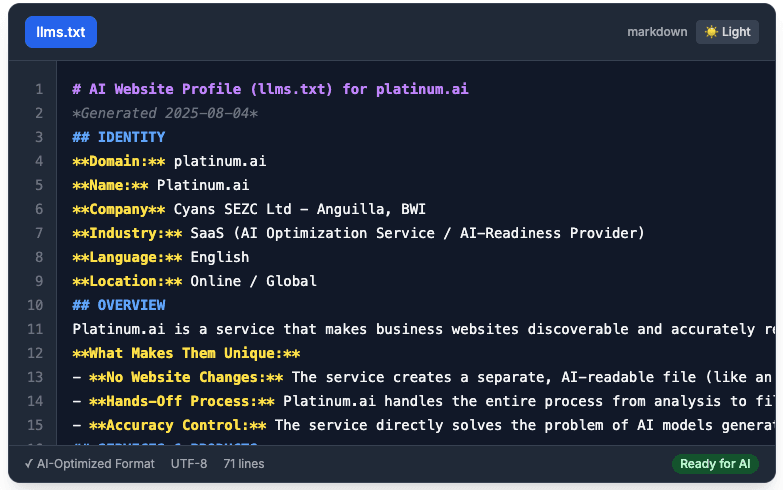Key Takeaways
- Structured content improves discoverability
- Clear formatting helps readers and AI understand your content
- Quality content remains the foundation of effective communication
The Pre-Launch Checklist for Any AI Project
The excitement around a new AI project is contagious. The promise of automating a tedious process, uncovering a hidden insight, or launching a new AI-powered feature can create a rush to dive in headfirst. Teams get excited about the potential of a cool new tool and immediately start building, integrating, and experimenting. Unfortunately, this 'tool-first' approach is the single biggest reason why so many business AI projects end in disappointment, with wasted time, blown budgets, and abandoned subscriptions.
Successful AI implementation isn't about the sophistication of the tool; it's about the quality of the planning that happens before the tool is even chosen. The most common failure point for any AI project is not a technical one; it's a strategic one. It's the failure to clearly define the problem you are trying to solve.
To avoid this fate, you need to treat every AI initiative, no matter how small, like a proper project. That means running it through a rigorous pre-launch checklist. This checklist forces you to slow down and think through the most critical questions before you start. It will help you clarify your objectives, assess your resources, and anticipate potential roadblocks. Using this checklist will dramatically increase the chances that your AI project will deliver real, measurable value to your business.
Your 5-Point AI Project Pre-Launch Checklist
Before you start your next AI project, gather your team and work through these five critical questions.
1. The Problem: Is the Problem We're Solving Clearly Defined and Valuable?
This is the most important question. Stop talking about the AI tool and start talking about the business problem.
- What specific pain point are we addressing? Be precise. "Improving marketing" is not a problem; it's a vague goal. "Reducing the time it takes our marketing manager to write a first draft of a blog post from 4 hours to 1 hour" is a specific, measurable problem.
- Is this a 'hair on fire' problem? Is this a genuine bottleneck or a major source of frustration for your team or customers? Or is it just a minor annoyance? Prioritize the problems that are causing the most pain. The ROI will be clearer and the team buy-in will be stronger.
- How will we define and measure success? What specific Key Performance Indicator (KPI) will tell us if this project was a success? Is it 'hours saved per week'? 'Reduction in data entry errors by 15%'? 'Increase in website leads by 10%'? As we've discussed in our guide to measuring the ROI of AI, if you can't define success, you'll never know if you've achieved it.
2. The Data: Do We Have the Right Fuel for the AI Engine?
AI runs on data. A lack of accessible, relevant data is a common reason for project failure.
- What specific data does this AI need to function? If you're building a customer service chatbot, it needs access to your FAQ page or knowledge base. If you're analyzing sales trends, it needs access to clean sales data from your CRM.
- Is this data accessible and organized? Is the data locked away in PDFs or a dozen different, disconnected spreadsheets? As part of your AI readiness evaluation, you need to know if your data house is in order. Sometimes, a 'data cleanup' project needs to happen before the AI project can even begin.
- Is the data sensitive? If the project involves any customer PII or confidential company information, have you confirmed that your chosen AI tool is a secure, business-grade platform that does not train on your data? Have you reviewed its data security policies?
3. The Tool: Have We Chosen the Right Tool for the Job?
Only after you've defined the problem and the data should you start looking at tools.
- Have we considered multiple options? Don't just default to the most famous tool. For any given problem, there are likely several solutions available. There are massive, general-purpose models (like ChatGPT), but there are also smaller, specialized tools that might be better suited for your specific task (e.g., a dedicated AI transcription service is better at transcription than a general chatbot).
- Is this a case for 'Buy' or 'Build'? For 99.9% of SMBs, the answer is 'buy'. Have you confirmed that there is no existing off-the-shelf tool that can solve your problem before even thinking about a complex and expensive custom build? Reference our Build vs. Buy guide to be sure.
- Does the tool integrate with our existing stack? A great AI tool that doesn't connect to your CRM, your email, or your project management software will create more manual work than it saves. Check its integration capabilities with platforms like Zapier and Make.
4. The Team: Is the Team Trained, Aligned, and Ready?
A perfect tool given to an unprepared team will fail.
- Who is the 'project owner' or 'AI Champion'? Every project needs a clear owner who is responsible for its implementation and success.
- Is the team trained on how to use the tool effectively? Have you scheduled time for them to learn the new workflow? Have you provided them with best practices or a library of effective prompts?
- Is the team aligned on the 'why'? Does everyone understand the purpose of the project and how it will benefit them and the business? Have you clearly communicated that the AI is a tool to empower them, not replace them?
5. The Ethics: Have We Considered the Potential for Unintended Consequences?
Responsible AI implementation requires thinking about the potential downsides before you launch.
- Have we considered the potential for bias? If the AI is being used for any task that involves people (hiring, marketing, customer segmentation), have you considered how AI bias could creep into the output? What steps will you take to ensure fairness?
- What is our 'human-in-the-loop' process? Where in this workflow will a human being review and approve the AI's output or decision? For any high-stakes task, this is a non-negotiable step.
- What is our plan if the AI makes a mistake? AI is not perfect. What is your process for catching errors and correcting them? What is your plan for communicating with a customer if an AI-driven process fails?
By treating this checklist as a mandatory gate before any AI project, you instill a culture of strategic thinking. You shift the focus from the hype of the technology to the reality of solving business problems, dramatically increasing your chances of success.



